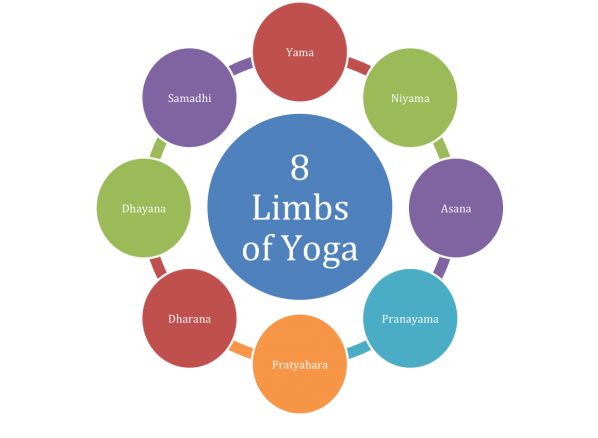What IS Yoga

What IS Yoga
In the last article, we saw What is NOT Yoga and here, we throw some light on What IS Yoga.
The basic tenets of yoga are outlined by the sage Patanjali in 200 AD in the classical Indian yoga text, the ‘Yoga Sutras.’ It is here, that we find the 8 limbs [Ashtanga] of yoga, a framework on which yoga and everything it encompasses is built upon.
Each limb relates to an aspect of achieving a healthy and fulfilling life, and each builds upon the one before it, outlining a path for the aspiring yogi to follow.
Yama (Moral Restraints)
Yama has to do with ethics, integrity and how we practice yoga off our mat. The five yamas are moral directives intended to guide the practitioner's behavior towards others.
Ahimsa: Non-violence, not hurting other beings physically or mentally
Satya: Truthfulness
Asteya: Not stealing
Brahmacharya: A balanced life, control over your senses and living without over- indulgence
Aparigraha: Not accumulating beyond ones needs & taking from nature only what is required
Niyama (observances)
Niyama is inner discipline and responsibility, how we treat ourselves. These are also called observances or the must do’s.
Saucha: Cleanliness or personal hygiene, including mental purity
Santosa: Contentment with oneself
Tapas: Self-discipline. Having the commitment to sustain a practice.
Svadhyaya: Self studying the nature of one’s own mind and doing inquiry into one’s own reality
Isvara Pranidhana: Surrender to a higher power with total acceptance
Asana (posture)
Asana is the physical posture and this is the limb that most of us are aware of. The yoga sutras define asana as – ‘Sthiram Sukham Asanam’, which means Asana is a posture that is steady and comfortable. Asana is an essential step towards the higher practices of yoga.
Pranayama (breath extension)
Pranayama means the regulation of breath. Breath and mind are closely related. If one can control the breath, one can control the mind and vise-versa. Pranyama is used to control, cultivate, and modify the Prana [energy] in the body. Pranayama gives steadiness and calmness to the mind.
Pratyahara (sensory withdrawal)
Pratyahara leads the mind inwards, preparing it for meditation. In pratyahara, the mind is withdrawn from the senses (touch, taste, see, hear and smell) and the sense objects, yet remaining fully aware of the inner processes. Pratyahara is the stage between externalizing and internalizing the mind. It is a stage where the mind can now dive deeper into its inner reality.
Dharana (concentration)
Dharana is focus or concentration. If the mind can be absorbed at a point or an idea or an object, it is called dharana. The goal is to still the mind — gently pushing away superfluous thoughts — by fixing your mind on some object such as a mantra, a candle flame, or on the third eye. In dharana, concentration is effortless.
Dhyana (meditation)
Uninterrupted meditation without an object is called dhyana. Dharana [concentration] leads to the state of dhyana [meditation.] The goal of meditation is not unconsciousness or nothingness. It is heightened awareness and oneness with the universe. In dhyana we dissolve separateness and experience the deep sense of peace.
Samadhi (enlightenment)
The ultimate goal of the eightfold path to yoga is samadhi or absolute bliss. Samadhi is complete, ecstatic transcendence moving beyond time, form and space. It's the goal of all yoga and the supreme state of consciousness. In this state – the meditator, the process of meditation and the object of meditation becomes one.
While the 8 limbs are mentioned separately in a sequence, they all ultimately merge with each other. This IS real yoga.
Namaste
